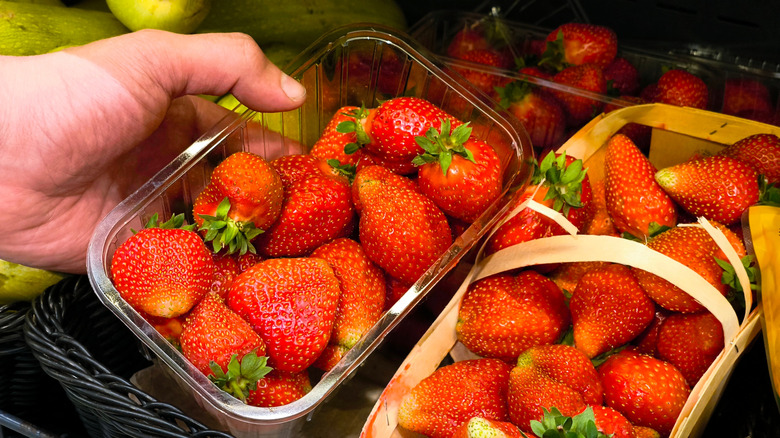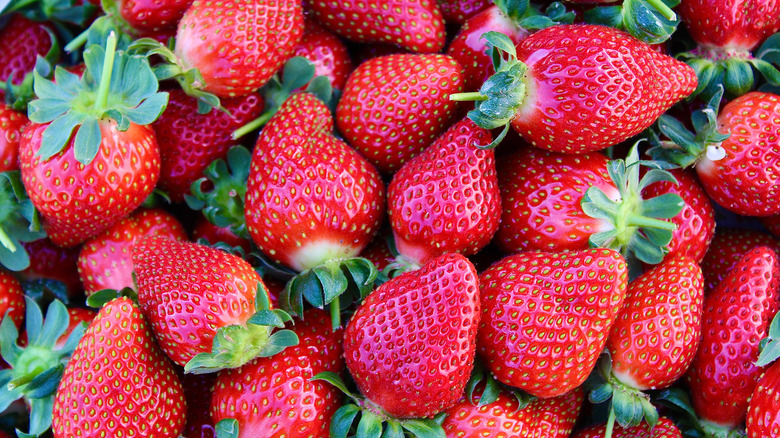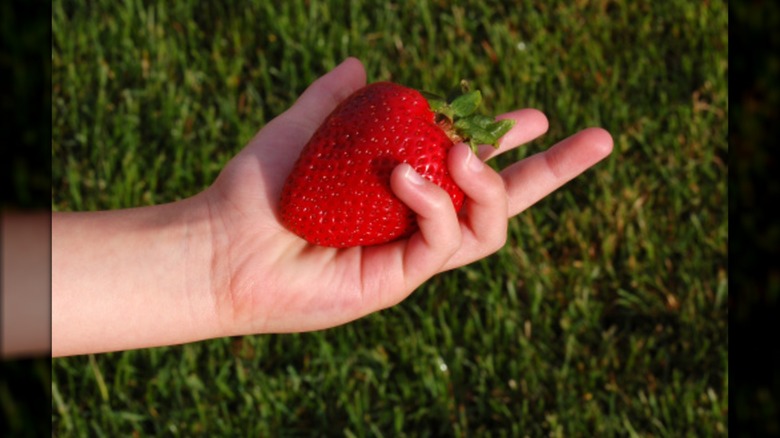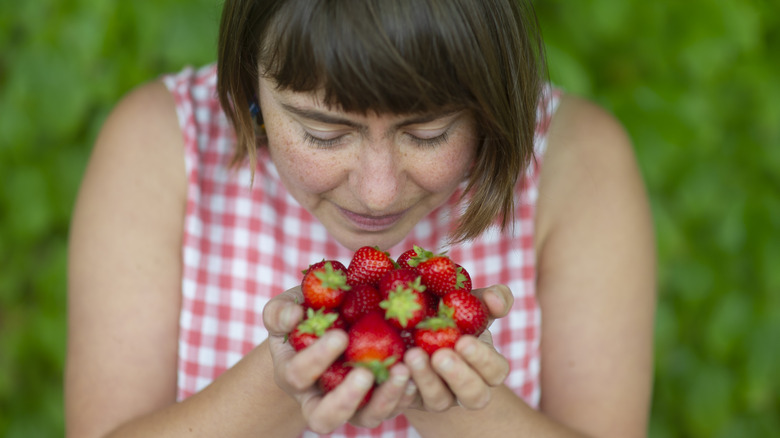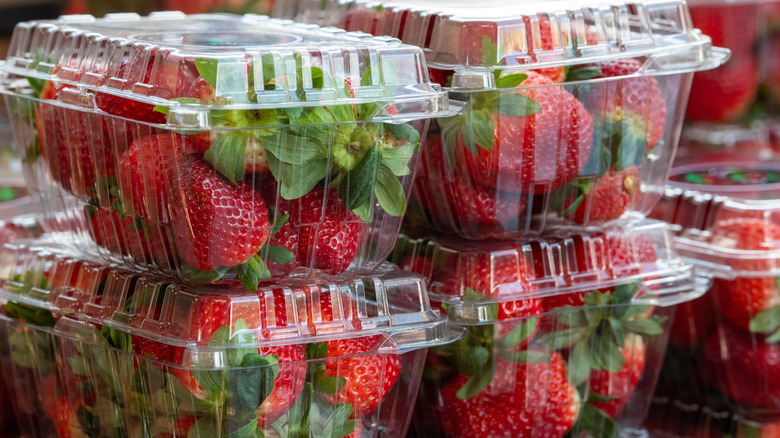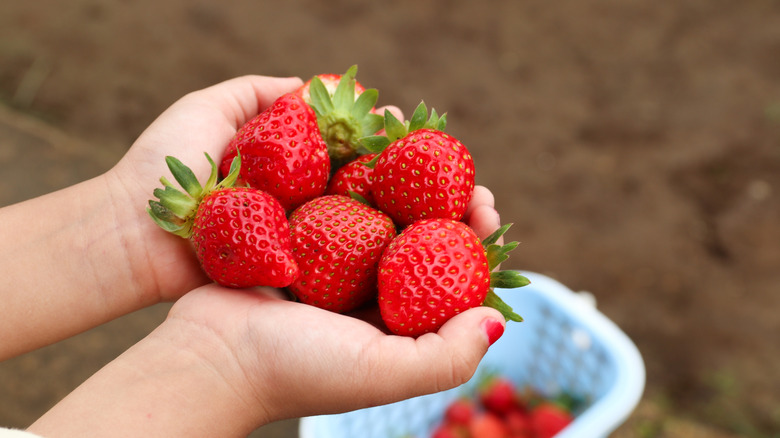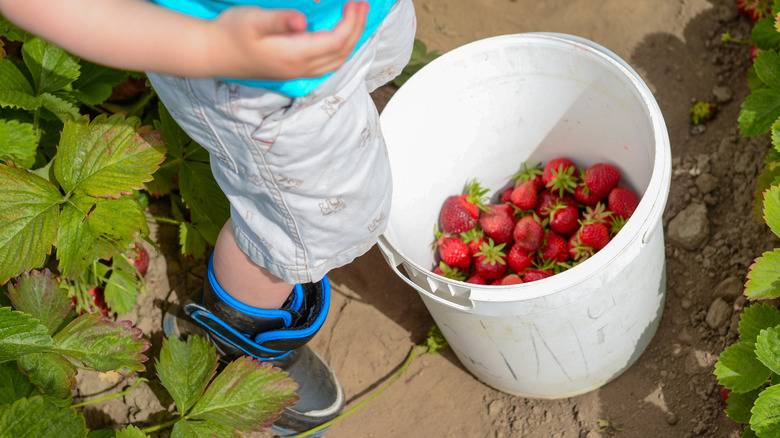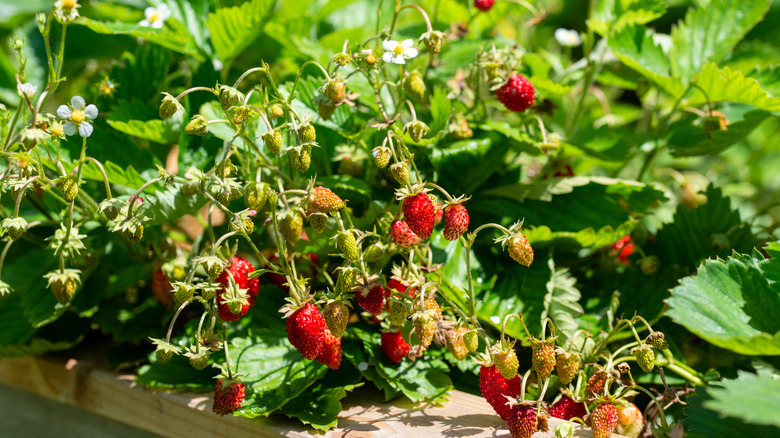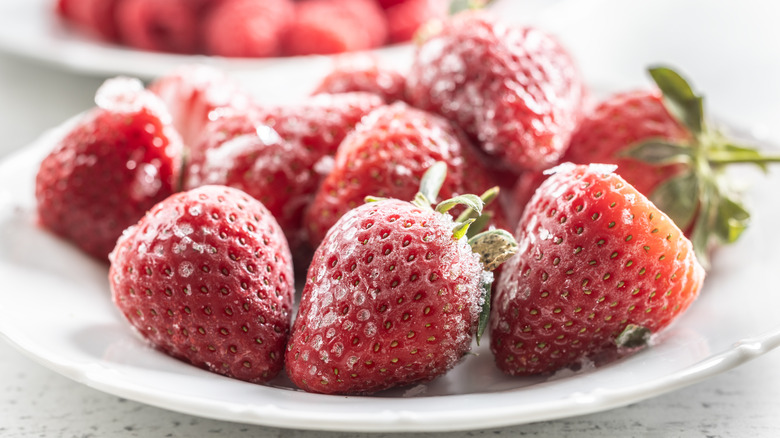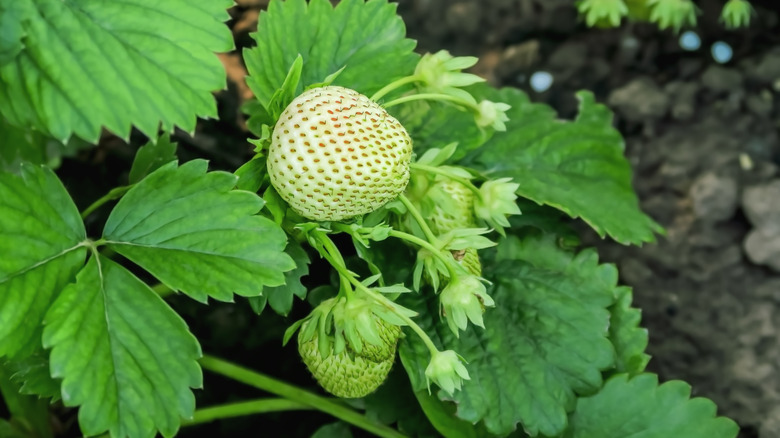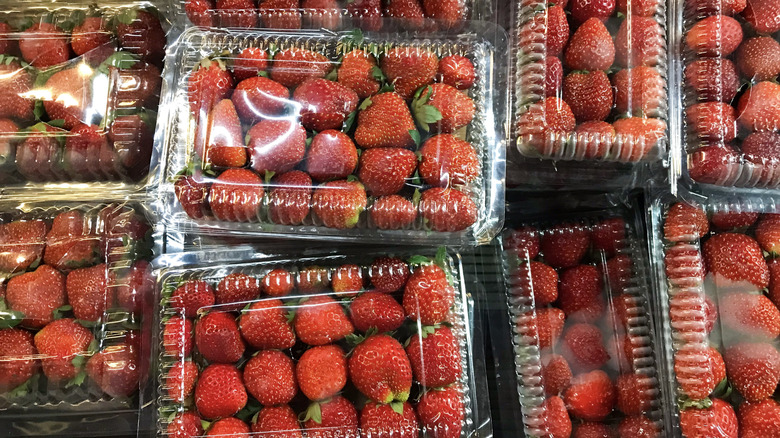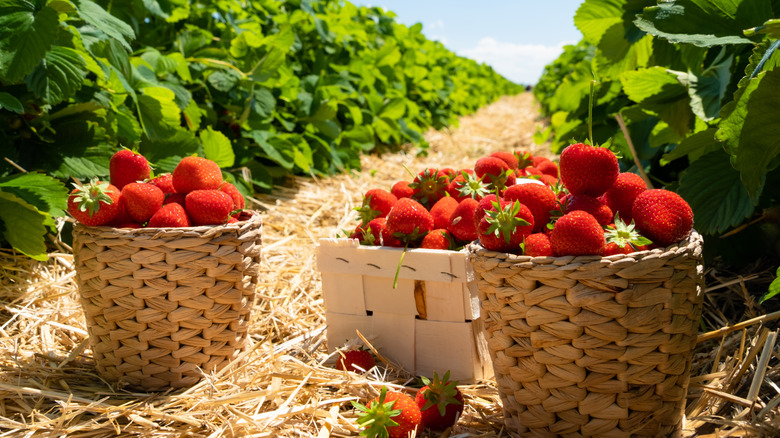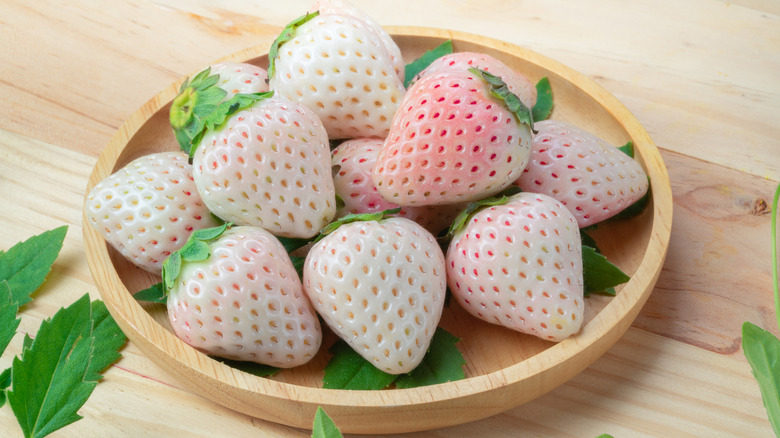13 Mistakes Everyone Makes When Buying Strawberries
Peak strawberry season is short, typically only lasting a few weeks. The season is not at the same time of year everywhere, either, with strawberry season kicking off earlier in the warmer, Southern states, and later in the cooler growing zones, such as in the Mid-Atlantic.
However, if you can catch that brief window of time when the berries begin to ripen, and make it to your local u-pick farm to snag some berries straight from the source, you'll be well-rewarded for making the effort. There's just something that much more delicious about a sun-ripened strawberry picked fresh.
For the rest of us, though, we have to settle for buying strawberries from the store. Thankfully, you can still have a delicious strawberry experience if you follow a few general guidelines. Not all strawberries at the grocery store are the same, and you may find one basket of bland, boring berries sitting right next to some of the best strawberries you've ever eaten in your life. Want to know how to tell the difference and make the right choice? These are the mistakes everyone makes when buying strawberries, and tips for how to avoid them.
Ignoring the strawberry tips
When considering how to pick ripe berries at the store, the tip of a strawberry can tell you a lot — and we're not just talking about the bottom tips, either. You'll need to look at both the bottom and top tips of your berries to glean some important information.
At the bottom tip of the strawberry, you're looking for a bright red color. If the lower tip of the berry is still green or white, this means that the strawberries weren't picked when they were fully ripe. Then, you'll also want to pull up the strawberry's leaves to check out the top tip, too. This end of the strawberry should be as red as possible, as well. If you want a strawberry that's super-sweet and juicy, make sure that top tip is a deep, dark red. If, however, you want a strawberry that's a little less juicy (like if you're making a baked treat and need a firmer berry that can stand up to some heat), or you'd like a strawberry that's a tad tart, then go for a berry with a top tip that's a less vibrant shade of scarlet.
Only going for the biggest berries
We get it. Everyone wants the big berries — and you'll definitely find a lot of large, seemingly oversized strawberries at the grocery store. Believe it or not, strawberries are getting bigger, due to a few reasons. Farmers want to grow bigger strawberries because the larger fruits have a longer shelf life, they are easier to pick, and their jumbo proportions mean that producers can put fewer berries in each box.
However, despite how you feel about big berries, if you really want the best, juiciest, sweetest strawberries, don't rely on size alone when picking between different cartons. While larger strawberries have their benefits, size is not an indicator of flavor or juiciness, and you may find that the smaller strawberries are just as tasty, if not more so. So, before automatically reaching for the carton of huge fruit, stop and make sure you're also checking for other indicators of ripeness and sweetness.
Neglecting to smell the strawberries
Sure, it might look a little strange, but lift up that carton of strawberries and give it a big ol' whiff. What do you smell? When seeking out ripe strawberries at the supermarket, smelling those fruits is just as important as giving them a thorough look over. A truly ripe strawberry will have a very specific smell.
There are three things you might pick up on when you sniff your strawberries. They could have a very bland or faint aroma. They could smell slightly fermented. Or they could smell very floral. You want to aim for strawberries that offer that floral scent, as that's a sign the strawberries are truly ripe. If the scent is very faint or even not there at all, then the strawberries were picked before they were ripe, and you're not going to get very good flavor. Bland smell equals bland flavor. On the other hand, if the aroma you pick up on is a little more on the fermented side, the strawberries are past their prime.
If you're not entirely sure what you're smelling when you sniff your strawberries, pick up a few different cartons and compare them. Once you get a hang of the way strawberries should smell versus how they shouldn't, you'll be able to rely on your nose for picking perfect berries in instances when appearance and touch just won't do the trick.
Picking strawberries without the stem
Yes, the stem can get in the way of your noshing, and it takes a little extra time for you to remove the leaves and stems if you're using the strawberries in a dish rather than just eating them on their own. However, purchasing strawberries with the stem intact can provide one big benefit: a longer shelf life.
Anyone who has ever watched a basket of berries in their fridge quickly go from perfect to gross already knows that strawberries (and berries in general) have a very short lifespan. With the right choices, though, you can extend that lifespan as long as possible. For example, fresh strawberries can last up to a week if you give them prime conditions — which means buying berries with their stems intact and then storing them at a temperature between 32 and 36 degrees Fahrenheit, and at 90-95% humidity. Your crisper drawer should do the job just fine, so long as your refrigerator is operating properly.
Forgetting to squeeze the berries
Just as you rely on your eyesight and sense of smell to pick the best berries, you should also rely on your sense of touch. Be careful, though. To test for ripeness, you don't want to thump on your strawberries the way you would when buying watermelon at the store. Likewise, you don't want to poke and prod the berries — that's one of the techniques to use while checking things to look for when buying salmon. Instead, take a very gentle approach, so as to avoid damaging the delicate strawberries.
The strawberries should be fairly firm. You don't want a strawberry that's hard and tough, as this is an indicator of the fruit being underripe, which could result in a poor texture on the inside and a lack of overall flavor. Likewise, you don't want a strawberry that's soft, as that's a sign that the berries are going bad, even if there are no visible cues of this just yet. (Those visible cues will include dark spots, wrinkled skin, a brown color, and, eventually, mold.)
Not visiting a u-pick strawberry farm
Of course, the best way to get the freshest berries possible is to go to the source: a farm that grows strawberries. When strawberries are at peak ripeness, many growers will open up their fields for visitors to pick their own fruit, in what is frequently called a u-pick farm experience. While you can rely on many of the tricks on this list to pick the best berries fresh from a plant, there are a few other considerations to keep in mind for finding the best berries in the field, and making sure they get home with you in one piece.
In addition to checking strawberry tips for that perfectly red hue, make sure that you're picking the berries gently so as not to damage them. You want to keep that stem and the leaves intact for a longer shelf life once you get the berries home — so try to sever the stem, using a slowly twisting movement, from the plant at about a half-inch up from the actual berry. It's also important to remember that we are not the only species that enjoys snacking on strawberries, so keep an eye out for any signs that might reveal when an animal took a bite out of the berry.
Failing to take advantage of strawberry season
Yes, we said that strawberry season is notoriously short — only lasting about three weeks in most areas of the country — but if you can take advantage of strawberry season, do so. While modern grocery stores make it convenient to buy strawberries at any time of year, the best berries come from a local source, when the strawberries are actually ripe in your neck of the woods. One big reason for this is that, in order to make the long-distance trip from a warm-weather farm to a grocery store in a cold climate, farms may pick the strawberries before they're fully ripe, so that they'll last longer. Since strawberries don't ripen further once they're picked, this means that outside of strawberry season, you most likely will not be able to find truly ripe strawberries in the produce aisle.
So when can you expect peak strawberry season to occur? In the warmest parts of the U.S. South, peak season can occur as early as February, with the season moving later into the year the further north you travel; in Maine, strawberry season occurs in June. Meanwhile, in some states, strawberries are grown year-round — such as in California, which produces nearly 90% of the country's strawberries.
Buying too many strawberries at once
One of the top mistakes everyone makes when buying produce at the grocery store — no matter what kind of fruits or veggies you're shopping for — is simply buying too much of it. In the best cases, strawberries can last about a week, if they're just chilling in your fridge ... but in the worst-case scenario, you may find that your strawberries start to show signs of going bad within a day or two. If you purchase way too many strawberries at once, before you can realistically eat or use them all, it's all the more likely that you're going to end up with some rotting, moldy berries.
If you've purchased too many strawberries, and you're worried that they're going to go bad before you can eat them, luckily, you have a few options to extend the lifespan of those berries. If you want to make your strawberries last for as long as possible, wash them in a solution of three parts water and one part white vinegar once you get them home, soaking them for 15 minutes. Don't rinse off the vinegar, but dry the berries thoroughly before storing them in a roomy container in the fridge. You can also freeze strawberries, which will preserve them for about a year.
Overlooking frozen strawberries
Don't overlook frozen strawberries when you're shopping at the grocery store, either. Yes, so far as taste is concerned, they hardly hold a candle to the fresh stuff — but frozen strawberries still have their merits. They're always ready to go in your freezer, where they'll last for a good long while. You can use them to make a three-ingredient strawberry butter, or include them in four-ingredient frozen Greek yogurt treats.
Whatever you do, just make sure that you defrost frozen strawberries properly, so that they don't end up as a soggy, mushy mess. If you have the time, let the frozen strawberries thaw overnight (or for at least eight hours) in the refrigerator. If your berry needs are more immediate, you can also place frozen strawberries in a zip-top plastic bag and let them thaw in cold water in the sink, much like how you might thaw frozen meat.
Buying unripe strawberries and expecting them to ripen later
So you picked up some unripe strawberries at the store. No big deal. You'll just set them on the counter and wait for them to ripen, right? Wrong. Strawberries do not ripen after they've been picked. As such, if the strawberries were picked before they were fully ripe, they're not going to get any better. You're stuck with your strawberries at the ripeness level that they are, and the only thing that's going to happen from here on out is that they'll eventually start to get rotten and moldy.
Luckily, you don't need to toss those underripe strawberries in the trash. While they might not be as juicy and sweet as their fully ripe counterparts, they still have their uses. Roast the strawberries, which will intensify the unripe fruit's otherwise dull flavors, and then use them in both sweet and savory dishes as a topping. If you think your strawberries aren't even ripe enough for this use, you can also pickle green strawberries for a very sour treat.
Buying strawberries that don't come in plastic clamshell containers
While buying fruit that comes packaged in plastic might seem environmentally unfriendly, you might actually want to go out of your way to purchase strawberries offered in a plastic clamshell container. This is because that type of packaging, with all its little air holes, is the perfect container for storing your strawberries at home in the fridge.
Even if you wash and dry your strawberries as soon as you get them home, if you plan to eat the berries within a few days, you may still want to return them to that plastic container, rather than tossing it and simply placing your berries in a bowl. The holes allow for greater air circulation, which is key for keeping your strawberries at their best for the longest amount of time possible. If you're in a hurry and don't have the capacity to wash the berries, you may even find that storing strawberries unwashed in their original container (after removing any berries that are actively going bad at the time of purchase) ensures that the fruit lasts longer than they might were you to store them in an airtight container after washing them.
Not buying organic strawberries
Eating fruits and vegetables is a great thing, but while you'll likely get the same nutrients from non-organic produce as you do with organic produce, the latter type has been shown to offer specific benefits. People who eat organic food long-term may experience fewer instances of cancer and pregnancy complications, due to the lower exposure to pesticides. Wondering what type of produce is exposed to more pesticides than any other? Strawberries.
According to the Environmental Working Group, strawberries are the likeliest fresh-produce item to contain pesticide residues, even after washing during processing and rinsing them at home before eating. These pesticides have been linked to cancer and reproductive issues, and the use of some of these chemicals are banned in Europe. As such, you may want to buy organic strawberries exclusively. If you don't get organic strawberries, you can soak them in a solution of vinegar and water or baking soda and water, which can help remove or neutralize pesticide residue as much as possible.
Assuming that all strawberries are the same
While we all know the ruby-red strawberries that you see in the grocery store, there are actually quite a few different types of strawberries, and you may want to pick a certain variety based on your intended use. Most commercially sold strawberries are the Monterey variety, as these strawberries are known to be juicy, large, and floral. However, other common varieties include the Allstar and Diamante, the former of which offers a slightly tart flavor (if that's what you're into), while the latter is plump and photogenic, so they are sometimes preferred for fancy desserts that keep the berries intact.
You can find specialty strawberry breeds, too, such as the Pineberry variety, which has an almost white shade of pink and, as the name suggests, offers a pineapple-adjacent flavor. Alpine strawberries are on the small side, with a concentrated burst of flavor. The Purén strawberry is rare — it only grows in Chile — and, like the Pineberry, it has an almost white appearance.
